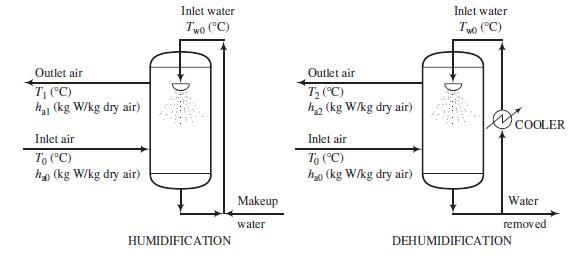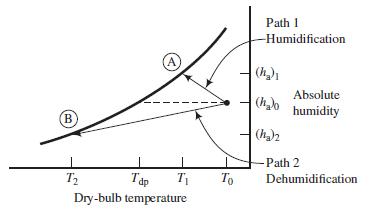Spray cooling is a technique for cooling and either humidifying or dehumidifying air by contacting it with
Question:
Spray cooling is a technique for cooling and either humidifying or dehumidifying air by contacting it with a spray of liquid water.

The liquid water leaving the tower is recirculated and, in the case of dehumidification, cooled before reentering the tower.
Two possible paths on the psychrometric chart corresponding to two different entering liquid temperatures are shown below. On the chart, T0 and Tdp are the dry-bulb temperature and dew point, respectively, of the entering air.

Path A: The entering liquid temperature (Tw0) is above the dew point of the entering air. Liquid water evaporates into the superheated air, causing the absolute humidity of the air to increase (the path rises) and both the evaporation and the contact with the cold liquid cause the air temperature to decrease (the path moves to the left).
Path B: The entering liquid temperature is below the dew point of the entering air. The temperature of the air contacted by the cold spray drops below the dew point (the path again moves to the left), and water vapor condenses out of the air (the path moves down).
We thus arrive at the interesting conclusion that you can remove water from air by spraying water into the air, provided that the entering liquid temperature is below the dew point of the entering air.
Use the psychrometric chart to solve the following spray-cooling problems.
(a) A spray tower is used to cool and humidify air with dry-bulb and wet-bulb temperatures of 40°C and 18°C, respectively. The air emerges from the tower at 20°C. The tower operation is such that the air follows an adiabatic humidification curve (a constant wet-bulb temperature line on the psychrometric chart). How much water must be added as makeup per kg of dry air treated?
(b) A stream of air at 37°C and 50% relative humidity flowing at a rate of 1250 kg/h is to be cooled to 15°C and dehumidified in a spray tower. The air is saturated as it emerges from the tower. Liquid water leaves the tower at 12°C; some is withdrawn, and the rest is cooled and recirculated. No heat is transferred between the tower and its surroundings. Calculate the rate (kg/h) at which water must be withdrawn from the recirculation loop and the heat duty on the cooler (kW). (Suggestion: Use an overall energy balance for the latter calculation.)
(c) A non-engineering friend of yours heard someone say that you can remove water from air by spraying water into it. He thought that sounded strange and came to you to you for clarification. He first asks “Is that possible?” and then adds, “If it is, how does it work?” In a short paragraph, state what you would tell him.
Step by Step Answer:

Elementary Principles of Chemical Processes
ISBN: 978-1119498759
4th edition
Authors: Richard M. Felder, Ronald W. Rousseau, Lisa G. Bullard





